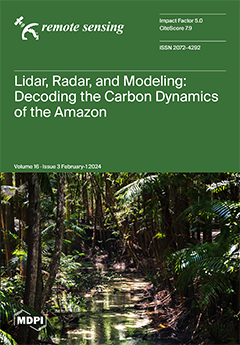Satellite-based hyper-spectral infrared (IR) sensors such as the Atmospheric Infrared Sounder (AIRS), the Cross-track Infrared Sounder (CrIS), and the Infrared Atmospheric Sounding Interferometer (IASI) cover many methane (CH
4) spectral features, including the ν1 vibrational band near 1300 cm
−1 (7.7 μm);
[...] Read more.
Satellite-based hyper-spectral infrared (IR) sensors such as the Atmospheric Infrared Sounder (AIRS), the Cross-track Infrared Sounder (CrIS), and the Infrared Atmospheric Sounding Interferometer (IASI) cover many methane (CH
4) spectral features, including the ν1 vibrational band near 1300 cm
−1 (7.7 μm); therefore, they can be used to monitor CH
4 concentrations in the atmosphere. However, retrieving CH
4 remains a challenge due to the limited spectral information provided by IR sounder measurements. The information required to resolve the weak absorption lines of CH
4 is often obscured by interferences from signals originating from other trace gases, clouds, and surface emissions within the overlapping spectral region. Consequently, currently available CH
4 data product derived from IR sounder measurements still have large errors and uncertainties that limit their application scope for high-accuracy climate and environment monitoring applications. In this paper, we describe the retrieval of atmospheric CH
4 profiles using a novel spectral fingerprinting methodology and our evaluation of performance using measurements from the CrIS sensor aboard the Suomi National Polar-orbiting Partnership (SNPP) satellite. The spectral fingerprinting methodology uses optimized CrIS radiances to enhance the CH
4 signal and a machine learning classifier to constrain the physical inversion scheme. We validated our results using the atmospheric composition reanalysis results and data from airborne in situ measurements. An inter-comparison study revealed that the spectral fingerprinting results can capture the vertical variation characteristics of CH
4 profiles that operational sounder products may not provide. The latitudinal variations in CH
4 concentration in these results appear more realistic than those shown in existing sounder products. The methodology presented herein could enhance the utilization of satellite data to comprehend methane’s role as a greenhouse gas and facilitate the tracking of methane sources and sinks with increased reliability.
Full article





